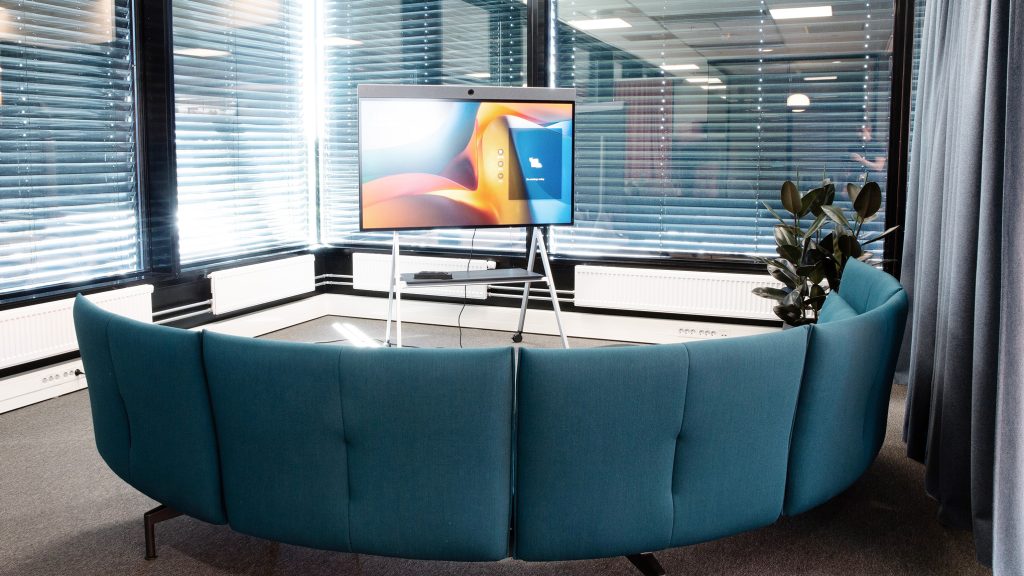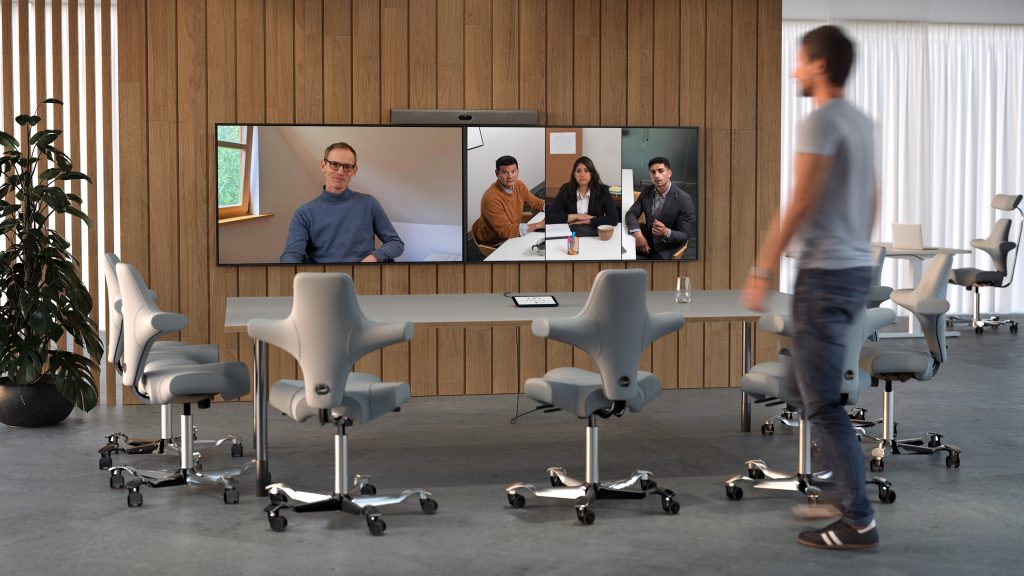How to Create a Remote Work Culture That Works: Tips and Ideas
Hayley Spooner, Aug 5, 2022

Maintaining a company’s unique culture remotely remains one of HR’s greatest challenges. While there’s some overlap with how organizations build a supportive culture in-house, there are also unique considerations for translating the culture in a remote work setting. Let’s look at some best practices for creating a strong remote work culture and why it matters.
Key takeaways:
- Remote work culture should reflect how employees embody a company’s core values even when they’re not physically surrounded by the organization on a daily basis.
- By finding ways to embody core values remotely, companies can lead by example and start transforming their remote employees to be extensions of the brand.
- Virtual work culture thrives on trust, routine, connectedness and support.
- Ideas for nurturing remote work culture include setting company traditions, communication guidelines and boundaries, plus providing employee recognition.
- Leverage technology to recreate in-person experiences to promote natural conversation, connection and engagement.
What Is Work Culture?
Workplace culture isn’t just about dress codes, sustainability missions and free pizza on Fridays. Rather, it’s the barometer of how well employees uphold the company’s mission and values. Many elements shape corporate culture, including:
- Job satisfaction
- Employee mental health
- Inclusion and diversity initiatives
- Growth and development opportunities
- The company’s ability to recruit and retain top talent
- Leadership style that promotes flexibility and autonomy
- A safe, productive work environment
In a physical workplace, employees have the visual benefit of seeing a company’s culture come to life. They gain a collective view of how people look and act in the office, their colleagues’ attitudes toward the company and how the company invests in its people for ongoing success.
In a remote work setting, culture is often built through implied knowledge of the company and how it operates. Employees don’t always have the benefit of seeing the ecosystem as a whole, or at least in large part. They’re often limited to their own roles and teams and have less insight into other employees’ work styles, attitudes, skills and abilities. The work environment also offers few clues, as one shared environment is replaced by multiple home offices that the company doesn’t manage or control.
When teams are physically distanced, building a strong remote work culture poses a bigger challenge. Ironically, the need for a strong culture is even greater when team members aren’t working side by side.
How Is Virtual Work Culture Created?
Generally, workplace culture isn’t something that should be left to chance. It’s an intentional, living, breathing entity that takes practice and careful nurturing. The same holds true with virtual culture.
Your culture will impact how customers and prospective employees (both in-person and remote) perceive your company. Because culture should reflect a company’s mission, values and people regardless of where employees are located, company leaders should flesh out what these look like and how they can demonstrate them from a distance.
In a remote setting where visuals are few and far between, embracing these values heavily relies on communication, technology and employee support.
Similar to in-person employees, remote employees also form subconscious perceptions of your company with every interaction, from the language you use to communicate to the tools that support their connectivity to your company. Ensuring remote employees feel connected, appreciated and empowered to do their jobs to their fullest ability remotely will help to build a healthy remote work culture. In turn, remote employees that feel valued and engaged are more likely to form positive perceptions of your organization.
Key Values of an Effective Remote Work Culture
One of the first steps to building a healthy remote work culture is to know what their ideal culture looks like. Among the most important characteristics are:
- A foundation of trust — Trust matters in any type of workplace setting, but it’s arguably more important in remote work. Managers and coworkers don’t have the benefit of seeing whether a teammate is engaged at work, completing tasks on time, or putting in a healthy number of hours. They also don’t know how their teammates are interacting with clients or other team members. Employees need to feel confident in their role and empowered to perform that role to their abilities. They also need to be able to trust each other that each person is working toward common goals and has the team’s and company’s best interests in mind.
- A focus on routine — Similar to an in-person work experience, routines can help employees feel more guided in their roles. They can set the right expectations for their responsibilities and plan ahead for team and solo initiatives.
- A feeling of connectedness — Remote employees shouldn’t feel isolated. They need to know their work is meaningful and how it fits into the larger ecosystem.
- A high level of support — In addition to connecting with fellow employees, they also need to know who to turn to with questions, concerns or support needs. They need to know the company has their best interests in mind and will provide all the tools and resources they need to do their jobs remotely.
Take Scott’s Cheap Flights, for example. This 100% remote company has employees all over the world, which can create some unique time zone challenges when collaborating with different teams. One way they overcome this is by providing video feedback instead of emails. They also set aside time to get to know each other.
Buffer has also taken a fully remote approach, even before the pandemic. They take a unique approach to remote work culture by collaborating on a managerial level. Executives can schedule 1:1 video feedback sessions with team leaders on a weekly basis if needed.
Tips for Embedding Work Culture in Your Remote Team
Building a virtual culture takes ongoing consistency and effort. It’s not a matter of checking a box on a list of remote work to-dos. When done well, your remote culture can become a powerful marketing, recruiting and retention tool.
Let’s look at some tips and culture ideas for remote work:
Create Company Traditions
From company cheers and sayings to monthly team-building sessions, companies can create new traditions that work for disparate teams. This gives employees something to look forward to, plus it helps them establish a routine with the company and build some team spirit.
Set Communication Standards
Setting the right expectations allows companies to hold their employees accountable. This also helps HR and recruiters better identify what a good cultural fit looks like so they can improve their hiring. Establish communication standards regarding which channels to use for different types of messages, response times, camera on/off requirements for video calls and other important details.
Reserve Time for Meaningful Work
Creating a remote culture of trust means allowing your employees the freedom to work independently without having to monitor their every move. Limiting meetings is a big part of this, as it ensures employees have ample time to work uninterrupted. It’s also important that you don’t require immediate responses to every request just to show the employee is engaged. They should be allowed to give their focus to the task at hand and respond at their next opportunity.
Recognize Remote Employees
Remote work culture should help employees see how their contributions matter. Just as you would recognize employees in person for a job well done, make sure you’re doing the same for your remote team.
Ask for Feedback
Asking for feedback allows you to spot potential remote culture issues before they become larger problems. This can be a simple survey or verbal request for feedback during one-on-one meetings. Or, you might hold dedicated feedback sessions with teams. Tools like Neat Board make it easy to collect and collaborate on feedback by wirelessly sharing content, making annotations and giving equal video presence to all participants.

9 Remote Work Culture Ideas for Engaging with Remote Employees
Remote engagement plays a big part in workplace culture. Keeping employees connected to the company and to each other allows them to experience the values that make your organization unique. Let’s explore some remote work culture ideas to keep employees engaged and create a stronger virtual culture:
1. Virtual Coffee Breaks and Happy Hours
Remote employees don’t have the benefit of going out for coffee or drinks with their teams, so bring the coffee or drinks to them! Video conferencing tools help you create this experience remotely, allowing coworkers to get to know each other beyond email and meetings.
Neat devices, such as the desktop-sized Neat Frame, add to this experience with superior sound quality that makes it easy to capture every word without background noise. It automatically adjusts the sound for clarity when two or more people are talking at the same time.
2. Home Tours
Remote video conferencing has given coworkers a unique advantage that’s absent in the physical workplace—a chance to peek into their home life. Companies can use this advantage to engage employees by allowing them to give tours of their homes or home offices. This is a great chance to show off their workspaces and setups, plus it gives other employees clues into each employee’s personality.
Likewise, in-house employees can engage remote workers by offering tours of the office so they can see where all the magic happens.
3. One-on-One Video Calls
For more personal or private conversations, one-on-one video calls are an easy way to stay connected with employees. Video calls are available on demand and allow you to see the other person’s reactions and facial expressions, helping leaders get a better sense of how their employees are feeling.
4. Gamification
Gamification is a growing trend in employee engagement. In essence, it allows employees to earn points for participation, which they can turn into prizes, rewards or badges. Examples of how to gamify employee engagement include awarding points or raffle entries for activities such as:
- Asking questions or speaking up during meetings
- Sharing helpful ideas
- Sharing company content on social media
- Achieving project milestones before deadlines
There are tons of ways to add to this list! Choose actions and rewards that make sense for your business.
5. Virtual Watercoolers
Employees often connect on-site via the watercooler, coffee bar or similar station. With remote work on the rise, companies are finding ways to recreate these experiences digitally. One example is a virtual water cooler, which fosters casual conversation like employees would have in person.
You can use purpose-built technology to create a virtual watercooler. Neat devices anchor this concept with clear visuals and audio, as well as technologies like Neat Boundary, which automatically removes background distractions to keep conversations focused and fun.
6. Pet Introductions
Remote employees aren’t always working solo. Sometimes, they bring in their pet coworkers for inspiration. Letting your employees introduce their furry coworkers is a fun way to engage your employees and showcase the entire team (not just the humans).
7. Health and Wellness Classes
There’s no doubt that employee physical and mental health impacts your company culture. Employees who are sick, stressed or burned out aren’t able to perform their best. Their shortcomings can create a negative impact on the rest of the team. Workplace stress isn’t tied to a physical space. It can happen anywhere, even remotely.
It’s important for companies to consider remote employees’ mental health and well-being just as much as if they were in the office. One way to support them is to offer health and wellness classes. This might be virtual yoga, healthy cooking classes, gym apps or something similar that can help them make health a priority.
8. Remote Professional Development
Investing in your employees’ growth is one of the most powerful actions a company can take to show appreciation. Your employees’ success is also your own, and professional development is a great way to engage your employees and help them keep growing.
Remote employees should be able to enjoy this same opportunity, even if the approach of providing professional development looks different compared to in-house teams.
One way to do this is to offer employees courses or training they can take online. Or, if you’re providing training sessions to in-house teams, consider a hybrid event option so that remote workers can join in, too. Carve out specific time they can take to engage in training so they don’t have to learn between meetings, phone calls and video conferences.
9. Special Interest Groups
Do some of your employees have school-aged kids? Do they like hiking or biking? Are they involved in local charities? Whatever they’re interested in, companies can build stronger connections with employees by relating to their interests.
Building employee connections outside of their own teams or departments is harder to do in a remote setting. Companies that want to build a supportive culture should be proactive in helping employees build these connections and feel more like part of the team.
Neat Board is a helpful tool in fueling special interest groups. Users can brainstorm and collaborate on-site and remotely via the whiteboard tools. It’s a great way to foster trust, improve communication and feel engaged with people they may or may not have ever met.
Building a Better Remote Work Culture with Neat
Building a remote work culture takes an intentional approach. While this process will look unique to each company, ensuring employees are seen, heard and connected is a step forward.
Neat improves remote connectivity with purpose-built solutions that enhance collaboration, communication and engagement. Explore Neat devices to empower your remote work culture.

Sources:
How Does A Company Create Great Culture Virtually? Forbes.
How to Build Remote Work Culture & Why It’s So Important. Miro.
Building and reinforcing a sustainable remote work culture. Gitlab.
Building a Positive Remote Working Culture. Wrike.
All-Remote Company: What It’s Like to Work at Scott’s Cheap Flights. Inhersight.




